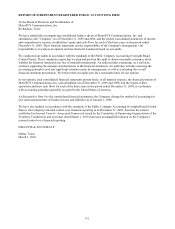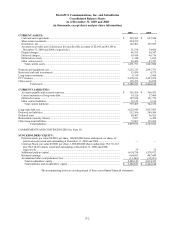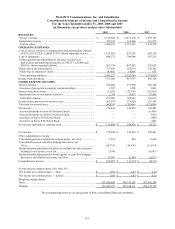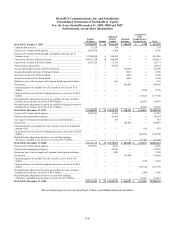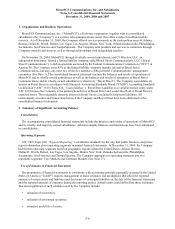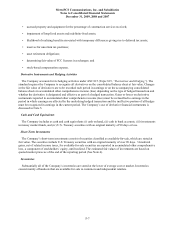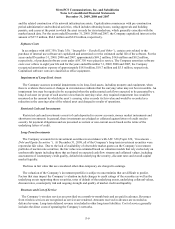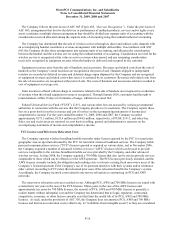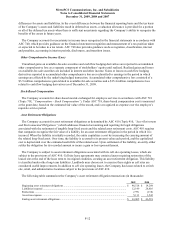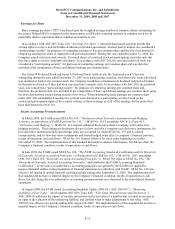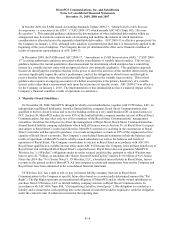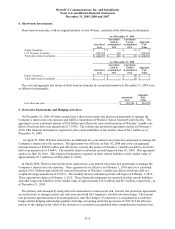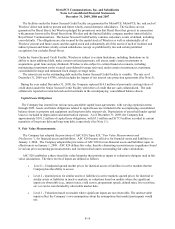Metro PCS 2009 Annual Report Download - page 124
Download and view the complete annual report
Please find page 124 of the 2009 Metro PCS annual report below. You can navigate through the pages in the report by either clicking on the pages listed below, or by using the keyword search tool below to find specific information within the annual report.MetroPCS Communications, Inc. and Subsidiaries
Notes to Consolidated Financial Statements
December 31, 2009, 2008 and 2007
F-10
The Company follows the provisions of ASC 605 (Topic 605, “Revenue Recognition”). Under the provisions of
ASC 605, arrangements that involve the delivery or performance of multiple products, services and/or rights to use
assets constitutes a multiple element arrangement that should be divided into separate units of accounting with the
consideration received allocated among the separate units of accounting using the residual method of accounting.
The Company has determined that the sale of wireless services through its direct and indirect sales channels with
an accompanying handset constitutes a revenue arrangement with multiple deliverables. In accordance with ASC
605, the Company divides these arrangements into separate units of accounting, and allocates the consideration
between the handset and the wireless service using the residual method of accounting. Consideration received for the
wireless service is recognized at fair value as service revenue when earned, and any remaining consideration
received is recognized as equipment revenue when the handset is delivered and accepted by the customer.
Equipment revenues arise from the sale of handsets and accessories. Revenues and related costs from the sale of
handsets in the Company’s retail locations are recognized at the point of sale. Handsets shipped to independent
retailers are recorded as deferred revenue and deferred charges upon shipment by the Company and are recognized
as equipment revenues and related costs when service is activated by its customers. Revenues and related costs from
the sale of accessories are recognized at the point of sale. The costs of handsets and accessories sold are recorded in
cost of equipment at average cost.
Sales incentives offered without charge to customers related to the sale of handsets are recognized as a reduction
of revenue when the related equipment revenue is recognized. Through January 2010, customers had the right to
return handsets within 30 days or 60 minutes of usage, whichever occured first.
Federal Universal Service Fund (“FUSF”), E-911, and various other fees are assessed by various governmental
authorities in connection with the services that the Company provides to its customers. The Company reports these
fees on a gross basis in service revenues and cost of service on the accompanying statements of income and
comprehensive income. For the years ended December 31, 2009, 2008 and 2007, the Company recorded
approximately $171.3 million, $135.6 million and $94.0 million, respectively, of FUSF, E-911, and other fees.
Sales, use and excise taxes are reported on a net basis in selling, general and administrative expenses on the
accompanying statements of income and comprehensive income.
FCC Licenses and Microwave Relocation Costs
The Company operates wireless broadband mobile networks under licenses granted by the FCC for a particular
geographic area on spectrum allocated by the FCC for terrestrial wireless broadband services. The Company holds
personal communications services (“PCS”) licenses granted or acquired on various dates, and in November 2006,
the Company acquired a number of advanced wireless services (“AWS”) licenses which can be used to provide
services comparable to the wireless broadband mobile services provided by the Company, and other advanced
wireless services. In June 2008, the Company acquired a 700 MHz license that also can be used to provide services
comparable to those which can be offered over the AWS spectrum. The PCS licenses previously included, and the
AWS licenses currently include, the obligation and resulting costs to relocate existing fixed microwave users of the
Company’s licensed spectrum if the Company’s use of its spectrum interferes with their systems and/or reimburse
other carriers (according to FCC rules) that relocated prior users if the relocation benefits the Company’s system.
Accordingly, the Company incurred costs related to microwave relocation in constructing its PCS and AWS
networks.
The microwave relocation costs are recorded at cost. Although PCS, AWS and 700 MHz licenses are issued with
a stated term, ten years in the case of the PCS licenses, fifteen years in the case of the AWS licenses and
approximately ten years for 700 MHz licenses, the renewal of PCS, AWS and 700 MHz licenses is generally a
routine matter without substantial cost and the Company has determined that no legal, regulatory, contractual,
competitive, economic, or other factors currently exist that limit the useful life of its PCS, AWS and 700 MHz
licenses. As such, under the provisions of ASC 350, the Company does not amortize PCS, AWS and 700 MHz
licenses and microwave relocation costs (collectively, its “indefinite-lived intangible assets”) as they are considered



